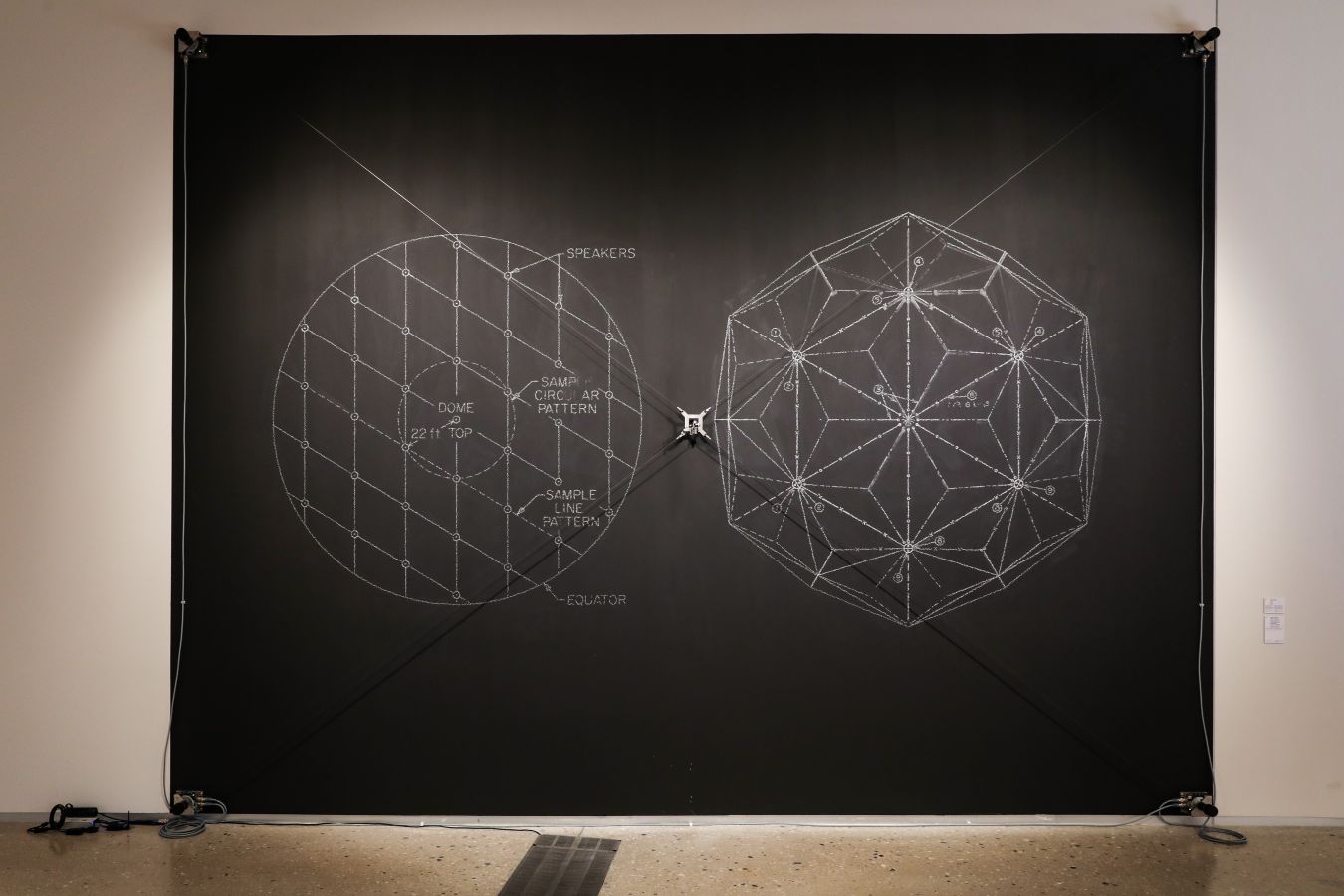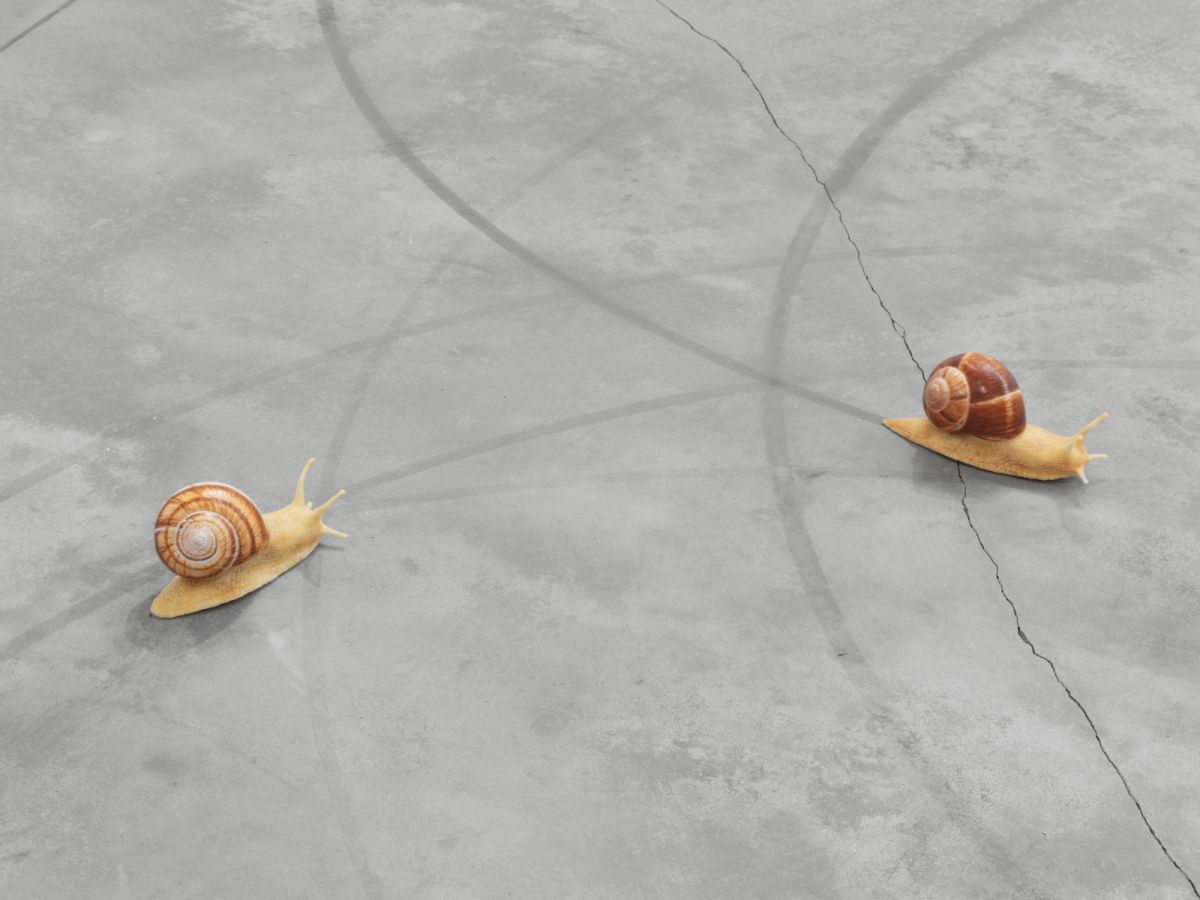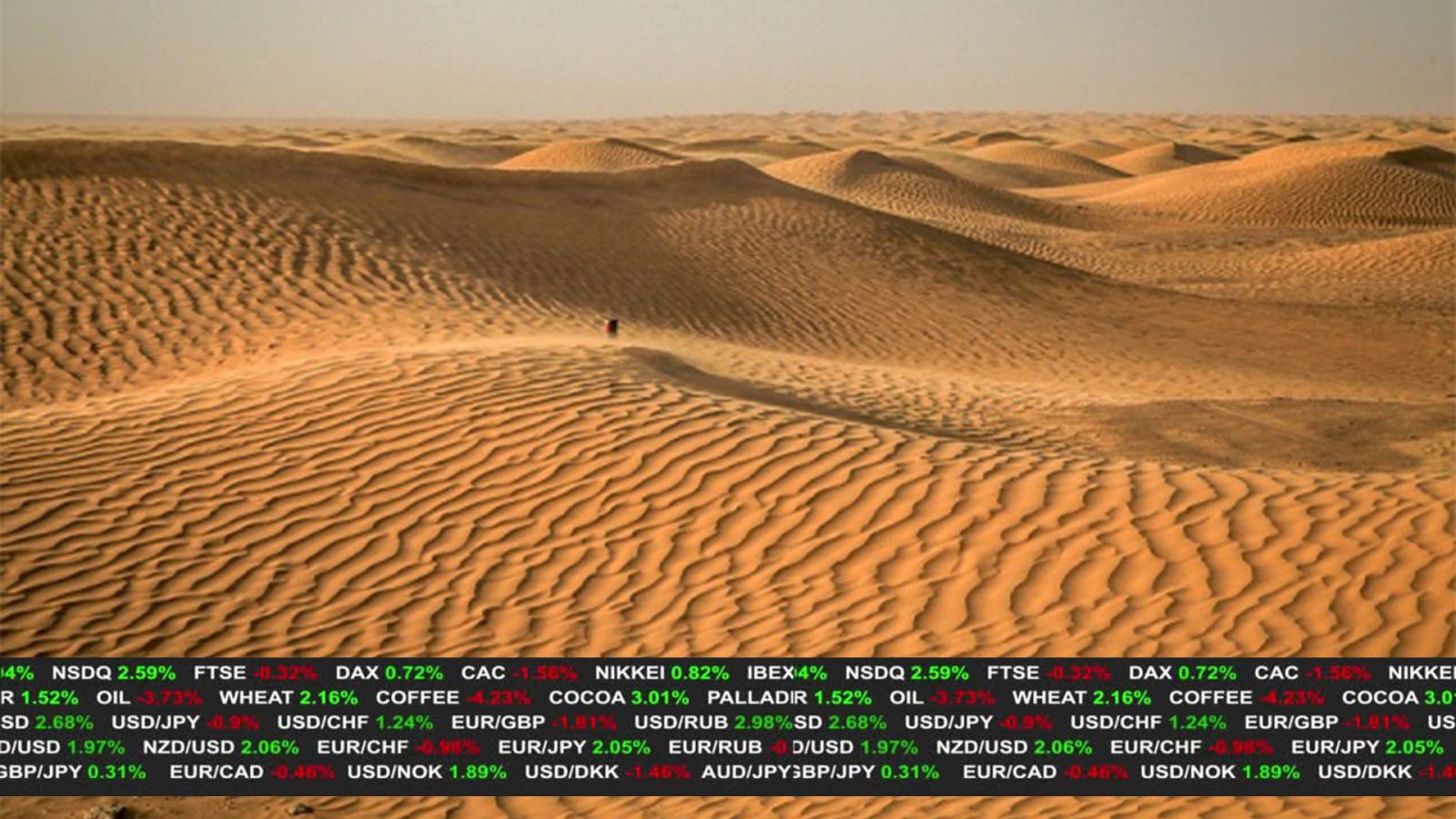Free entry
Durant l’hiver 2020, EPFL Pavilions consacre son programme au thème de la robotique afin de susciter une réflexion sur les perspectives et scénarios émergents de ce domaine en pleine expansion. La prémisse de Nature of Robotics est d'offrir un regard non conventionnel sur le sujet de la robotique et d'étendre sa compréhension à des notions plus larges, situées à la frontière entre la science et les arts visuels. La robotique modulaire, reconfigurable, souple, micro et bio manifeste les scénarios émergents d'une discipline en constant renouvellement.

Vue d'exposition
Nature of Robotics: An Expanded Field, 11.12.2020 – 16.05.2021, EPFL Pavilions
© image EPFL Pavilions, photo: Alain Herzog

Vue d'exposition
Nature of Robotics: An Expanded Field, 11.12.2020 – 16.05.2021, EPFL Pavilions
© image EPFL Pavilions, photo: Alain Herzog

Melissa Dubbin & Aaron S. Davidson
Delay Lines, (feedback), 2020
Commissioned and produced in the framework of the EPFL Pavilions / CDH Artist in Residence programme 2020
Courtesy: the artists
Nature of Robotics: An Expanded Field, 11.12.2020 – 16.05.2021, EPFL Pavilions
© image EPFL Pavilions, photo: Alain Herzog

Vue d'exposition.
Nature of Robotics: An Expanded Field, 11.12.2020 – 16.05.2021, EPFL Pavilions
© image EPFL Pavilions, photo: Alain Herzog

Katja Novitskova
Pattern of Activation (Mamaroo nursery, dawn chorus), 2017
Courtesy: the artist and Kraupa-Tuskany Zeidler, Berlin.
Exhibition view. Nature of Robotics: An Expanded Field, 11.12.2020 – 16.05.2021, EPFL Pavilions
© image EPFL Pavilions, photo: Alain Herzog

Melissa Dubbin & Aaron S. Davidson
Delay Lines, (feedback), 2020
Commissioned and produced in the framework of the EPFL Pavilions / CDH Artist in Residence programme 2020
Courtesy: the artists
Nature of Robotics: An Expanded Field, 11.12.2020 – 16.05.2021, EPFL Pavilions
© image EPFL Pavilions, photo: Alain Herzog

Urs Fischer
Maybe, 2019
Motors, gears, aluminium, plastic, battery, brass, silicone, magnets, two-component urethane casting resin, acrylic paint, xanthan gum, gum arabic, ethanol, charging station. Edition 2 of 2 & 2 AP. Private collection. Courtesy: the artist.
Nature of Robotics: An Expanded Field, 11.12.2020 – 16.05.2021, EPFL Pavilions
© image EPFL Pavilions, photo: Alain Herzog

Jürg Lehni
Otto, 2015
Computer-controlled chalk drawing machine
Motor modules, stainless steel ribbon coils, automated chalk holder, custom-made controller and software
Nature of Robotics: An Expanded Field, 11.12.2020 – 16.05.2021, EPFL Pavilions
© image EPFL Pavilions, photo: Alain Herzog

Jürg Lehni
Otto, 2015
Computer-controlled chalk drawing machine
Motor modules, stainless steel ribbon coils, automated chalk holder, custom-made controller and software
Nature of Robotics: An Expanded Field, 11.12.2020 – 16.05.2021, EPFL Pavilions
© image EPFL Pavilions, photo: Alain Herzog

Scientific display
EPFL School of Engineering, Reconfigurable Robotics Laboratory (RRL), Professor Jamie Paik
Robogami Design
Mori: Modular Origami Robots, Soft Robotics
Hydrogel-based artificial muscles. © Nebahat Yenihayat and EPFL MICROBS, MicroBioRobotic System Laboratory, Prof. Selman Sakar
EPFL School of Engineering, Biorobotics Laboratory (BioRob), Professor Auke Ijspeert
Orobot
Exhibition view. Nature of Robotics: An Expanded Field, 11.12.2020 – 16.05.2021, EPFL Pavilions
© image EPFL Pavilions, photo: Alain Herzog

Scientific display
EPFL School of Engineering, Reconfigurable Robotics Laboratory (RRL), Professor Jamie Paik
Robogami Design
Mori: Modular Origami Robots, Soft Robotics
Hydrogel-based artificial muscles. © Nebahat Yenihayat and EPFL MICROBS, MicroBioRobotic System Laboratory, Prof. Selman Sakar
EPFL School of Engineering, Biorobotics Laboratory (BioRob), Professor Auke Ijspeert
Orobot
Exhibition view. Nature of Robotics: An Expanded Field, 11.12.2020 – 16.05.2021, EPFL Pavilions
© image EPFL Pavilions, photo: Alain Herzog

Alexandra Daisy Ginsberg
Designing for the Sixth Extinction, 2013–2015
Courtesy: the artist
Nature of Robotics: An Expanded Field, 11.12.2020 – 16.05.2021,, EPFL Pavilions
© image EPFL Pavilions, photo: Alain Herzog

Exhibition view.
Nature of Robotics: An Expanded Field, 11.12.2020 – 16.05.2021, EPFL Pavilions
© image EPFL Pavilions, photo: Alain Herzog

Agnes Denes
Visual Philosophy, 1968–2018
Courtesy: the artist and Leslie Tonkonow Artworks + Projects, New York
Nature of Robotics: An Expanded Field, 11.12.2020 – 16.05.2021, EPFL Pavilions
© image EPFL Pavilions, photo: Alain Herzog

Agnes Denes
Liberated Sex Machine, 1969-70/2013
Hand-pulled lithograph on blue Plike paper. 48.3 x 62.9 cm. Edition of 30.
Courtesy the artist and Leslie Tonkonow Artworks + Projects, New York
Nature of Robotics: An Expanded Field, 11.12.2020 – 16.05.2021, EPFL Pavilions
© image EPFL Pavilions, photo: Alain Herzog

Haseeb Ahmed
Stock Weather, 2020
Wood, electronics, custom software, steel, sand, 3D prints
Thanks to: Atelier Vilvoorde, Peter Heremans, Adrien Lucca
Commissioned by EPFL Pavilions
Courtesy: the artist and Harlan Levey Projects
Nature of Robotics: An Expanded Field, 11.12.2020 – 16.05.2021, EPFL Pavilions
© image EPFL Pavilions, photo: Alain Herzog

Suzanne Treister
SURVIVOR (F), 2016–present
ASICENE
Post-Singularity Epoch of Artificial Super Intelligence Inhabitation of Earth, 2018
SURVIVOR (F)/Watercolour diagrams
Courtesy: the artist, Annely Juda Fine Art, London and P.P.O.W. Gallery, New York
Exhibition view. Nature of Robotics: An Expanded Field, 11.12.2020 – 16.05.2021, EPFL Pavilions
© image EPFL Pavilions, photo: Alain Herzog

Suzanne Treister
SURVIVOR (F), 2016–present
ASICENE
Post-Singularity Epoch of Artificial Super Intelligence Inhabitation of Earth, 2018
SURVIVOR (F)/Watercolour diagrams
Courtesy: the artist, Annely Juda Fine Art, London and P.P.O.W. Gallery, New York
Exhibition view. Nature of Robotics: An Expanded Field, 11.12.2020 – 16.05.2021, EPFL Pavilions
© image EPFL Pavilions, photo: Alain Herzog

Basim Magdy
M . A . G . N . E . T, 2019
Super 16 mm film transferred to Full HD. Colour and black and white, 21 min.
Commissioned by MAAT Museum of Art, Architecture and Technology, Lisbon. Courtesy: the artist and artSümer, Istanbul.
© image EPFL Pavilions, photo: Alain Herzog

Claudia Comte
Bunnies Emitting, 2018
4D animation. 2’08” min. Loop. Courtesy: the artist and Galerie KÖNIG.
Nature of Robotics: An Expanded Field, 11.12.2020 – 16.05.2021, EPFL Pavilions
© image EPFL Pavilions, photo: Alain Herzog

Katja Novitskova
Pattern of Activation (Mamaroo nursery, dawn chorus), 2017
Courtesy: the artist and Kraupa-Tuskany Zeidler, Berlin.
Exhibition view. Nature of Robotics: An Expanded Field, 11.12.2020 – 16.05.2021, EPFL Pavilions
© image EPFL Pavilions, photo: Alain Herzog

Katja Novitskova
Pattern of Activation (Mamaroo nursery, dawn chorus), 2017
Courtesy: the artist and Kraupa-Tuskany Zeidler, Berlin.
Exhibition view. Nature of Robotics: An Expanded Field, 11.12.2020 – 16.05.2021, EPFL Pavilions
© image EPFL Pavilions, photo: Alain Herzog

Léa Pereyre with PATHOS, Wyss Zurich
Anima I, 2019
Animated by PATHOS robotic tools
Paper & PATHOS animation modules
PATHOS: Poetic Animatronics Through Hands-On Systems
Courtesy: the artists, Wyss Zurich (UZH + ETHZ), ETH Zurich, Gebert Rüf Stiftung Faulhauber Minimotor Sa.
Nature of Robotics: An Expanded Field, 11.12.2020 – 16.05.2021, EPFL Pavilions
© image EPFL Pavilions, photo: Alain Herzog

Léa Pereyre with PATHOS, Wyss Zurich
Anima I, 2019
Animated by PATHOS robotic tools
Paper & PATHOS animation modules
PATHOS: Poetic Animatronics Through Hands-On Systems
Courtesy: the artists, Wyss Zurich (UZH + ETHZ), ETH Zurich, Gebert Rüf Stiftung Faulhauber Minimotor Sa.
Nature of Robotics: An Expanded Field, 11.12.2020 – 16.05.2021, EPFL Pavilions
© image EPFL Pavilions, photo: Alain Herzog
A travers les travaux d'artistes et les productions scientifiques des laboratoires de l'EPFL, Nature of Robotics invite à une réflexion contemporaine sur la place des agents artificiels dans nos écosystèmes naturels et sociaux. Les visions qui émergent des laboratoires sont juxtaposées à des créatures spéculatives, des dessins, des diagrammes et des vidéos produits par des artistes contemporains.
Nature of Robotics revisite la notion de ‘champ élargi’, en écho à l'expression de Rosalind Krauss "le champ élargi de la sculpture" ; cette notion est utilisée ici comme une approche curatoriale qui inscrit la robotique dans une réflexion liée à l'environnement.
La COVID-19 a introduit un nouveau sentiment de précarité, et le rôle des technologies est remis en question à la lumière d'un phénomène mondial qui nous remet en cause à notre niveau le plus fondamental. Tout comme Bruno Latour l'avait prévu en relation avec la crise écologique, "tout le tissu de l’existence" 1 est impliqué dans notre réponse à la COVID-19. Le virus nous a minés d'abord dans notre corps, puis dans nos habitudes, intensifiant notre dépendance à la technologie pour la survie et la communication ; à l'origine même de la pandémie se trouvent les conséquences de notre relation controversée avec l'environnement et la violente altération des écosystèmes. Les perturbations causées par la pandémie ont recadré nos préoccupations : à une échelle profondément imbriquée, les animaux et les hommes, l'environnement, la biologie et la technologie apparaissent comme les facteurs interdépendants d'une crise en cours. Tous sont les acteurs/agents de ce qui pourrait être un dépassement, voire une transcendance de ses forces destructrices.
Nature of Robotics élargit le champ de cette réflexion, en remettant en question la robotique en tant que science ; elle révèle comment les avancées et les développements technologiques sont structurellement dépendants d'un processus d'investigation et d'apprentissage par ‘l'observation’ du monde naturel. Observateurs prudents et créateurs inventifs, artistes et scientifiques explorent les complexités de nos écosystèmes biologiques.
- Notre traduction ↩

Basim Magdy, New Acid, 2019
Super 16mm et messages texte générés par ordinateur transférés en Full HD
14 min. 18 sec. Commande de La Kunsthalle Mulhouse, France
Avec l'aimable autorisation de l'artiste et de artSümer, Istanbul

Basim Magdy, M . A . G . N . E . T, 2019
Film Super 16mm transféré en Full HD. Couleur et noir et blanc, 21 min. Commande du MAAT Museum of Art, Architecture and Technology, Lisbonne.
Avec l'aimable autorisation de l'artiste et de artSümer, Istanbul

Agnes Denes
The Kingdom Series, X-Ray of Sting Ray, 1980
Sérigraphie en quadrichromie avec coloriage métallique et manuel
Avec l'aimable autorisation de l'artiste et Leslie Tonkonow Artworks + Projects, New York

Katja Novitskova
Pattern of Activation (Mamaroo nursery, dawn chorus), 2017
Détail.
Avec l'aimable autorisation de l'artiste et Kraupa-Tuskany Zeidler, Berlin. Photo: def image

Katja Novitskova
Pattern of Activation (Mamaroo nursery, dawn chorus), 2017
Vue de l'installation
Avec l'aimable autorisation de l'artiste et Kraupa-Tuskany Zeidler, Berlin; Photo: def image

Claudia Comte
Bunnies Emitting, 2018
4D animation. 2’08” min. Boucle
Avec l'aimable autorisation de l'artiste et Galerie KÖNIG

Urs Fischer Maybe, 2019
© Urs Fischer. Avec l'aimable autorisation de l'artiste, The Modern Institute, et Gagosian. Photo: Stefan Altenburger

Alexandra Daisy Ginsberg
Autonomous Seed Disperser de Designing for the Sixth Extinction, 2013-15
Avec l'aimable autorisation de l'artiste

Alexandra Daisy Ginsberg
Rewilding with Synthetic Biology de Designing for the Sixth Extinction, 2013-15
Avec l'aimable autorisation de l'artiste

Haseeb Ahmed
Stock Weather, 2020
Commandée par EPFL Pavilions. Avec l'aimable autorisation de l'artiste et Harlan Levey Projects

Melissa Dubbin & Aaron S. Davidson
Delay Lines, 2019
Détail
Collection de Ishikawa Foundation, Okayama © Dubbin & Davidson

Jurg Lehni
Otto, 2015, Two Legacies – Footnotes from the History of Two Cultures
E.A.T., Pavilion: Experiments in Art And Technology, 1972
Avec l'aimable autorisation de l'artiste
Loin d'une présentation historique de l'art robotique, l'exposition entend néanmoins reconnaître cette tradition, notamment à travers l'œuvre pionnière de Jean Tinguely. D'une part, son travail rappelle la tradition de l'art mécanique et, d'autre part, inaugure la notion d'"expansion" et d'"environnement" à travers un film tourné dans le désert du Nevada en 1962, anticipant la théorisation ultérieure de Krauss.
L'itinéraire de l'exposition conduit le visiteur du désert du Nevada de Tinguely au ciel du Nevada de Trevor Paglen. les escargots robotisés d'Urs Fischer, le robot artificiel souple sous la forme d'une raie manta de Melissa Dubbin et Aaron S. Davidson, les créatures de Lea Pereyre, la mouche (Musca domestica) de Adrien Missika, Otto, la machine à dessiner de Jürg Lehni, sont en relation avec une série de modèles récents de robots dans une alternance de vertébrés amphibiens, de microrobots biocompatibles, de robots origami à l'échelle des insectes et modulaires, et leurs applications associées dans des environnements à plusieurs échelles allant des fluides physiologiques à l'espace.
La Visual Philosophy d'Agnes Denes ponctue l'espace d'exposition ; le regard d'Alexandra Daisy Ginsberg sur la biologie synthétique et les films de Basim Magdy, interrogent métaphoriquement les trajectoires ouvertes par la recherche scientifique. Les visions d'un sublime post-futuriste de Suzanne Treister, tandis que les créatures quasi science-fiction de Katja Novitskova alimentées par l'imagerie du Laboratoire de systèmes MicroBioRobotiques de l'EPFL et les animations visqueuses de Claudia Comte, renvoient à un futur hypothétique. L’installation site-specific d’Haseeb Ahmed établit un parallèle entre la bourse mondiale et les phénomènes météorologique, et les photographies de Trevor Paglen, rappellent l'implication des technologies robotiques dans les pratiques de guerre et de surveillance.

Hydrogel-based artificial muscles.
© Nebahat Yenihayat and EPFL MICROBS, MicroBioRobotic System Laboratory, Prof. Selman Sakar

Mori
© Reconfigurable Robotics Lab (RRL) and Raphaël Galeuchet

OroBOT
BioRobotics Lab EPFL © Alessandro Crespi, EPFL

Pompes extensibles pour machines souples
© Vito Cacucciolo and LMTS, EPFL 2019
Reconnaissant l'"expansion" comme une méthode, l'exposition explore l’intérêt de "penser le champ élargi" comme une façon d'aborder le réseau de plus en plus interconnecté des discours artistiques et scientifiques. Les récits qui traversent l'espace conduisent à la création de telles connexions. Grâce à une séquence orchestrée de manifestations artistiques et scientifiques, l'exposition élargit ainsi le champ de la robotique pour la comprendre comme une discipline à plusieurs niveaux, magnifiant notre observation, notre connaissance et notre imagination des environnements et des écosystèmes passés et futurs.
